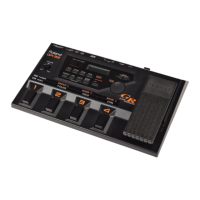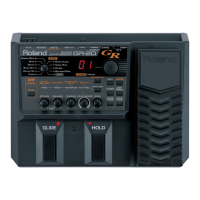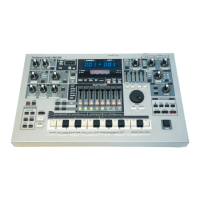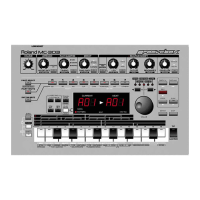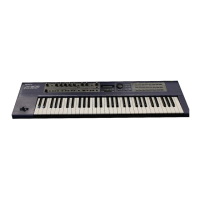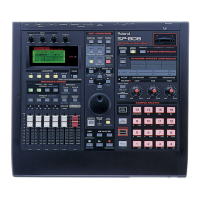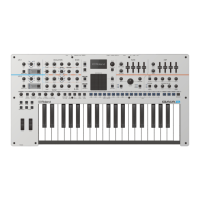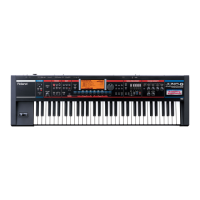Saving Patches From the GR-30
to Sequencers or Other MIDI
Devices (Bulk Dump)
Settings of all user patches, and all system settings
may be transferred in and out using MIDI. By using
external equipment that can record MIDI data, you
can also save patches externally. For this kind of
operation, MIDI messages called “system exclusive
messages,” which can be interpreted only by those
types of devices designated in that data, is used.
For example, data either sent from the GR-30, read
from a floppy disk, or entered by other means can be
saved using a MIDI sequencer’s real time recording or
bulk librarian function. You can also send/receive
data directly with another GR-30 by connecting the
two together.
<Sending System Settings or Patch Data to an
External MIDI Device>
1. Turn off the power to the GR-30.
2. Connect the GR-30’s MIDI OUT to the MIDI IN
connector on the external MIDI device.
3. While pressing (stepping on) pedal 3, turn the GR-
30 back on. “ALL” will appear in the display.
4. Using the [+] and [-] buttons, switch to the follow-
ing displays. Select the data you want to send
from these.
ALL (Data) ..................All user patches and sys-
tem settings
SyS (System Setup)..System settings
PAt (Patch Data)......All user patches (128
patches)
A— (A Group) ............The 32 patches A11 to A84
b— (b Group) .............The 32 patches b11 to b84
C— (C Group) .............The 32 patches C11 to C84
d— (d Group) .............The 32 patches d11 to d84
A11 (Patch A11) .......Patch A11 only
A12 (Patch A12) .......Patch A12 only
::
d84 (Patch d84)........Patch d84 only
5. Put the external MIDI device in record mode.
(Start the sequencer’s real-time recording. The
GR-30, even when receiving data, needs no special
preparation.)
6. When you press [EDIT/PLAY], the data selected
in step 4 is sent to the external equipment. While
the information is being sent, the message “Snd.”
(Sending) flashes.
7. Sending is complete when the previous display
returns. If the sequencer is on the receiving end of
a transfer, stop recording at this point. After the
GR-30 is finished sending, turn it off and then on
again (restart) to resume normal operation.
●●●●●●●●●●●●●●●●●●●●●●●●●●●●●●●●●●●●●●●●●●●●●●●●●●●●●●●●●●●●●●●●●●●●●●●●●●●●●●●●●●●●●●●●●●●●●●●●●●●●
<What about Receiving Previously Saved System and Patch Data?>
As long as it is turned on, the GR-30 can usually
receive exclusive messages. Just by sending (or
returning) the data via the GR-30’s MIDI IN, the GR-
30 can replay data sent to the accompanying external
MIDI device anytime.
●●●●●●●●●●●●●●●●●●●●●●●●●●●●●●●●●●●●●●●●●●●●●●●●●●●●●●●●●●●●●●●●●●●●●●●●●●●●●●●●●●●●●●●●●●●●●●●●●●●●
✽
Only when sending a single patch, one from A11 to d84
as described in step 4 above, back to the GR-30 is it nec-
essary to carry out the patch write procedure (p. 30).
(Since you designate an address to save to at the same
time you write the patch, you won’t need to copy to a
patch with a number other than the original one already
used as a temporary place-holder.)
✽
Except for sending A11 through d84 (as single patches),
no conditions apply for rewriting patch or system set-
ting data at the receiving end when receiving exclusive
messages with system or patch data. As data can other-
wise be lost, exercise due caution. When necessary, back
up your data from the GR-30.
31
5

